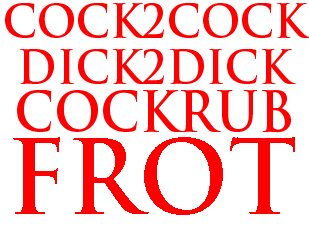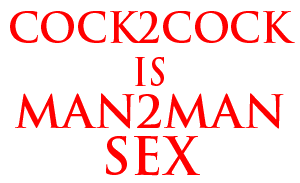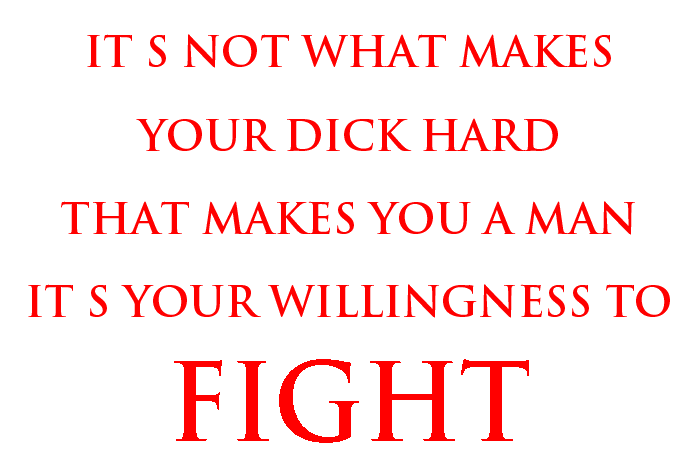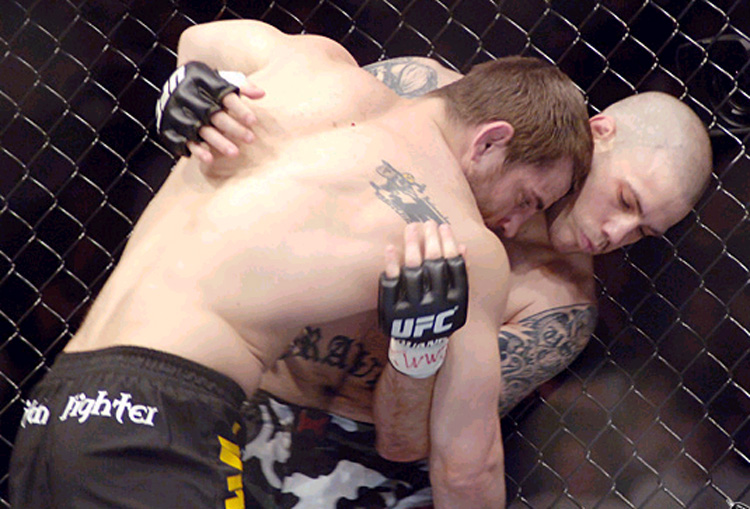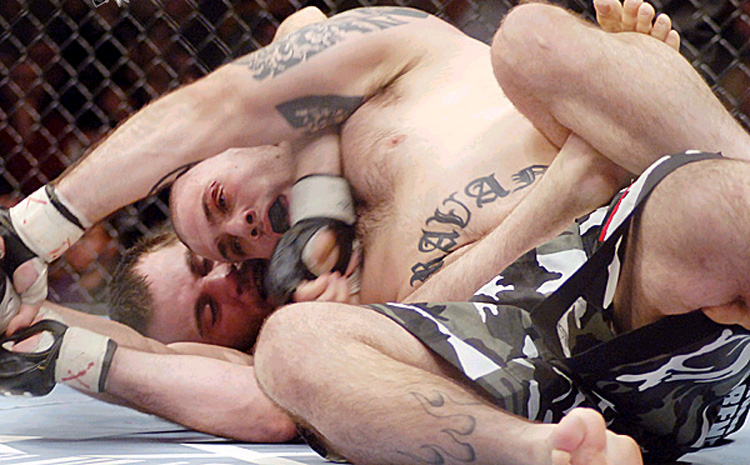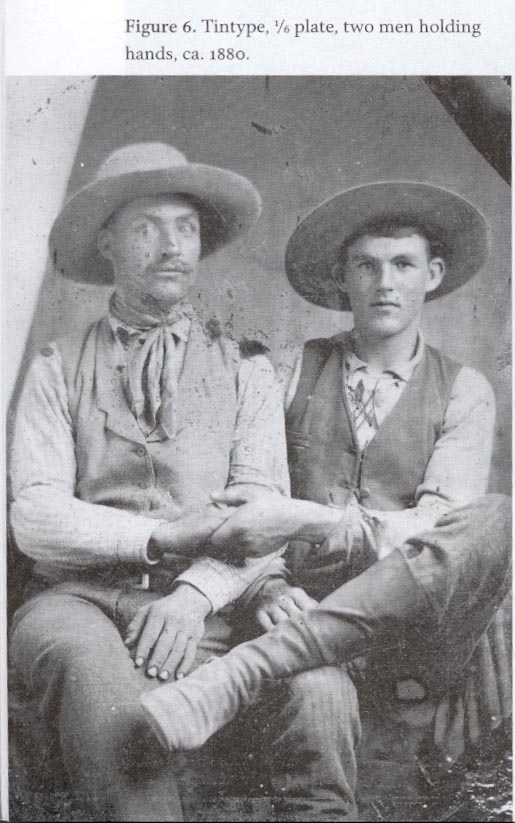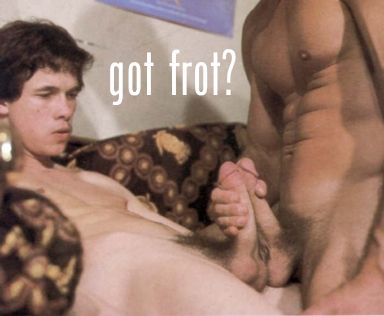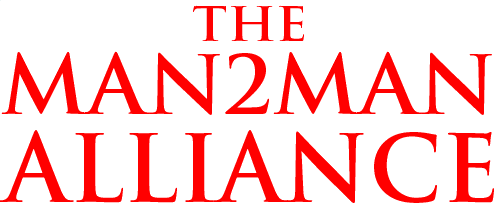


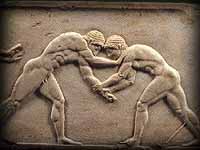

Warriorhood and Male Intimacy
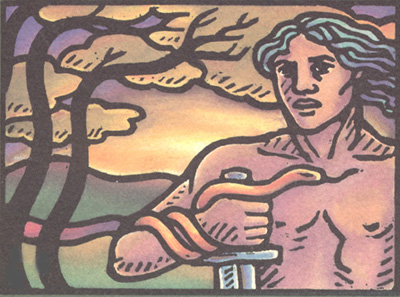


Warriorhood and Male Intimacy
9-5-2007
Introductory note from Bill Weintraub:
This post from Redd, and the accompanying reply from myself, orginally appeared in The Deification of Antinous message thread.
Because that's a long thread, I'm posting Redd's thoughts and my reply here on their own as well.
These thoughts, about Masculinity, Brotherhood, Warriorhood, and Male Intimacy, are important, and knowing that not everyone reads all of every thread, I want to be sure that guys have a chance to see them.
Here's Redd:
Warriorhood and Male Intimacy
8-24-2007
Bill, the straight guys who want man2man don't want intimacy. They are no different than the promiscuous gays who lust. Hence, straight and gay think the same way. They haven't grasped brotherhood/warriorhood. They indeed play heterosexism's script: they want to fuck around, which is deceptive and abusive because they're using another person.
Perhaps because the terms "brotherhood" and "warrior" have been silenced in men's lives. The married guy who claims to love his wife but have need for masculine rapport understands what his social identity has scripted for him. He understands deception: sneaking around to be with other men. He understands lust: screw anyone and don't establish a bond. He understands promiscuity. And they understand all this because they believe in the either/or straight/gay identification of men.
In other words, they believe in two types of men: real or straight and non-real or gay. They believe that real men aren't man2man, can't be; so the best way to maintain the facade of the masculine is to deceive and fool around in secret. They don't understand brotherhood or warriorhood. They don't appreciate the masculine. They really don't know the masculine.
Once again, that ignorance about what masculine is, what brotherhood is, is one of the reasons our work is so important.
Re:The Deification of Antinous
8-27-2007
Thank you Redd.
Another great post.
Let's take a look:
Bill, the straight guys who want man2man don't want intimacy. They are no different than the promiscuous gays who lust. Hence, straight and gay think the same way. They haven't grasped brotherhood/warriorhood. They indeed play heterosexism's script: they want to fuck around, which is deceptive and abusive because they're using another person.
Right.
Redd says, "the straight guys who want man2man don't want intimacy."
That's correct.
There's something more important and more powerful than sex, and that's intimacy.
When we look at some of the old photographs in an exhibit like Dear Friends --
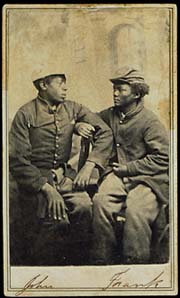
we can't know for certain whether these guys "had sex" with each other.
But we can be sure that they were intimate.
We can see it in their faces and their body language.
Intimacy.
A key component of friendship and of what Redd calls "Warriorhood," which is a communal sharing and exaltation of Manhood.
But and again, as Redd says,
the straight guys who want man2man don't want intimacy. They are no different than the promiscuous gays who lust. Hence, straight and gay think the same way. They haven't grasped brotherhood / warriorhood.
Neither the gay-identified nor the straight-identified guys "have grasped brotherhood / warriorhood."
Because in our heterosexualized society, that sort of male-male intimacy is both figuratively and literally BEYOND their grasp.
Society, in other words, not only no longer makes it possible for these men to grasp Warriorhood -- society makes it IMpossible.
The result: Both "categories" of men, which are both equally false,
indeed play heterosexism's script: they want to fuck around, which is deceptive and abusive because they're using another person.
Right.
Heterosexism's script, which Redd talked about in To see masculinity and masculine love as sacred, and which we discussed again in The myth of male promiscuity -- heterosexism's script imposes a false or social identity -- a pseudo-masculinity -- over and upon Man's Natural Masculinity.
That script requires that men eschew intimacy and love in favor of abuse and lust.
That's what the script is about.
It seeks to destroy the sacred bonds between men -- because those bonds threaten heterosexualization's societal control.
Which is why, as Redd says,
the terms "brotherhood" and "warrior" have been silenced in men's lives.
Those terms -- "brotherhood" and "warrior" -- which combined make up and constitute "Warriorhood" -- have to be silenced in order for the heterosexualized society -- to remain in power.
It's that simple.
Warriors, Brotherhood, and Warriorhood -- all threaten the heterosexualized order.
So they're denigrated, derided, censored, silenced -- extinguished.
Snuffed out.
Redd:
The married guy who claims to love his wife but have need for masculine rapport understands what his social identity has scripted for him.
Right.
He's learned his role well.
He understands deception: sneaking around to be with other men. He understands lust: screw anyone and don't establish a bond. He understands promiscuity. And they understand all this because they believe in the either/or straight/gay identification of men.
In other words, they believe in two types of men: real or straight and non-real or gay. They believe that real men aren't man2man, can't be; so the best way to maintain the facade of the masculine is to deceive and fool around in secret. They don't understand brotherhood or warriorhood. They don't appreciate the masculine. They really don't know the masculine.
Again, that's exactly right.
What these males know is what heterosexualization allows them to know:
the pseudo-masculine.
The pseudo-masculinity of promiscuity, of deceit, of empty sex and loveless lust.
What these males don't know, and will never know, unless and until they are liberated, is the Naturally Intimate Love of Man for Man.
Which is an outgrowth and outcome of the development of their NATURAL Masculinity.
Their true Masculinity.
Redd:
Once again, that ignorance about what masculine is, what brotherhood is, is one of the reasons our work is so important.
Yes.
Remember that Hadrian and Antinous were about brotherhood;
as were these guys we see in the tondo:
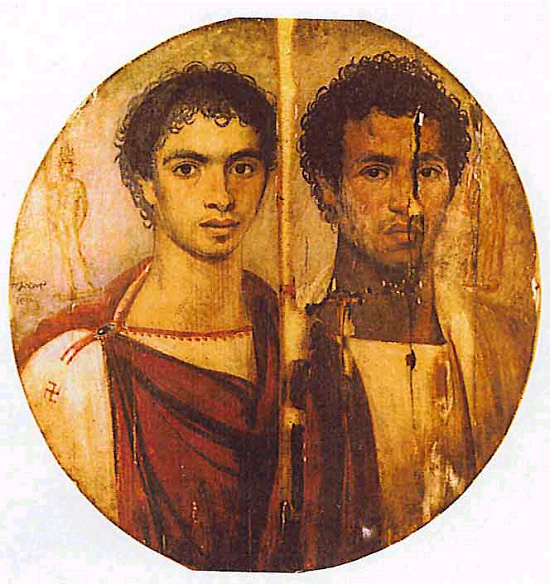
These were people involved in mystery religions, like Mithraism, which, through their emphasis on bravery, fidelity, manly devotion, and male fellowship, provided a great sense of brotherhood.
And Warriorhood.
Hadrian and Antinous were intimate.
In the truest sense.
An intimacy born of a love which was pure and strong.
Intimacy.
Redd began his post with these words:
"the straight guys who want man2man don't want intimacy" --
Right.
Because they've been told that "real men" aren't intimate -- emotionally close -- with other men.
But Men have had intimacy with other Men -- for millenia.
A few days back, in the reply I posted to Chuck Tarver's You can't tell a fish he's all wet!, I included some pictures from World War II.
These are pictures of male intimacy:
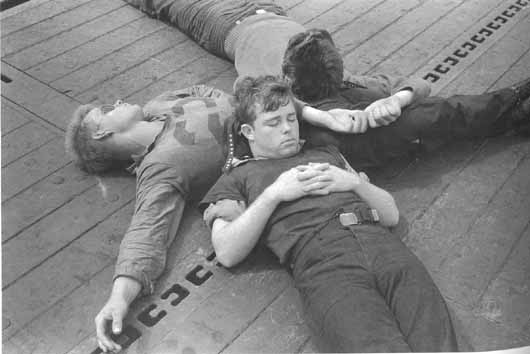
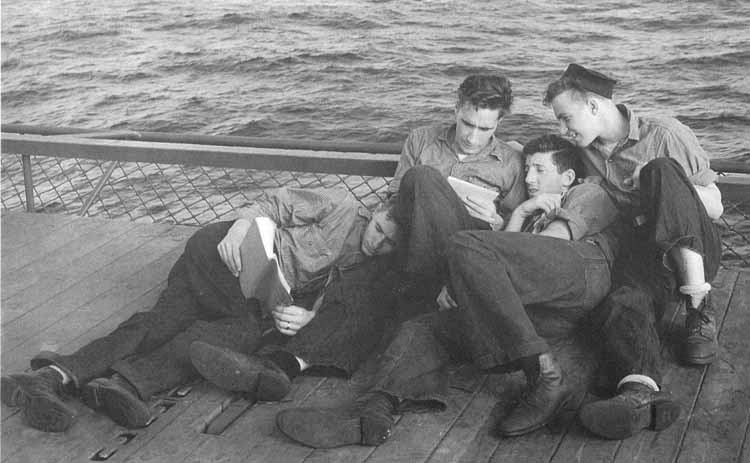
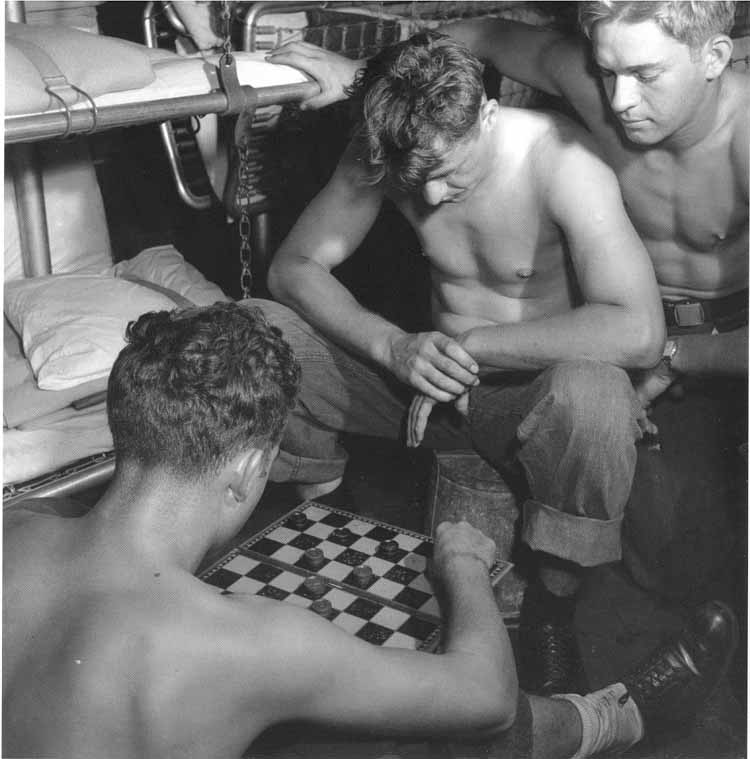
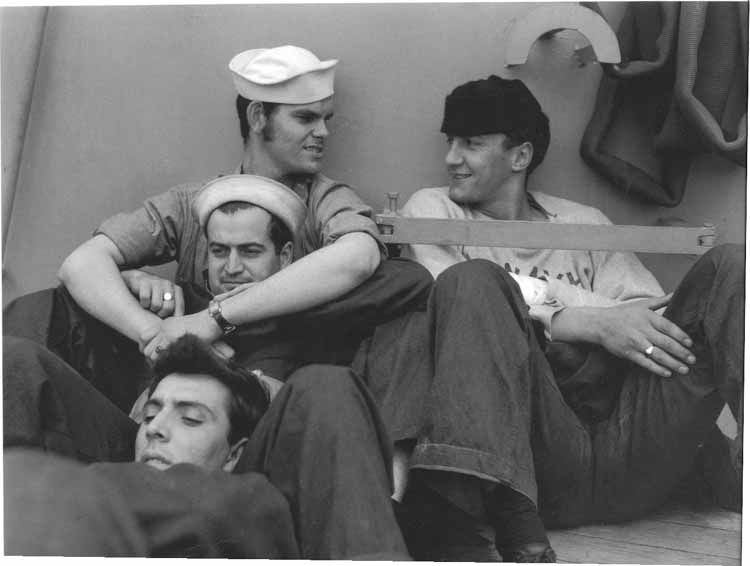
Those images are from World War II; but this sort of intimacy is not and was not unique to that war.
Here's an image from 1870:
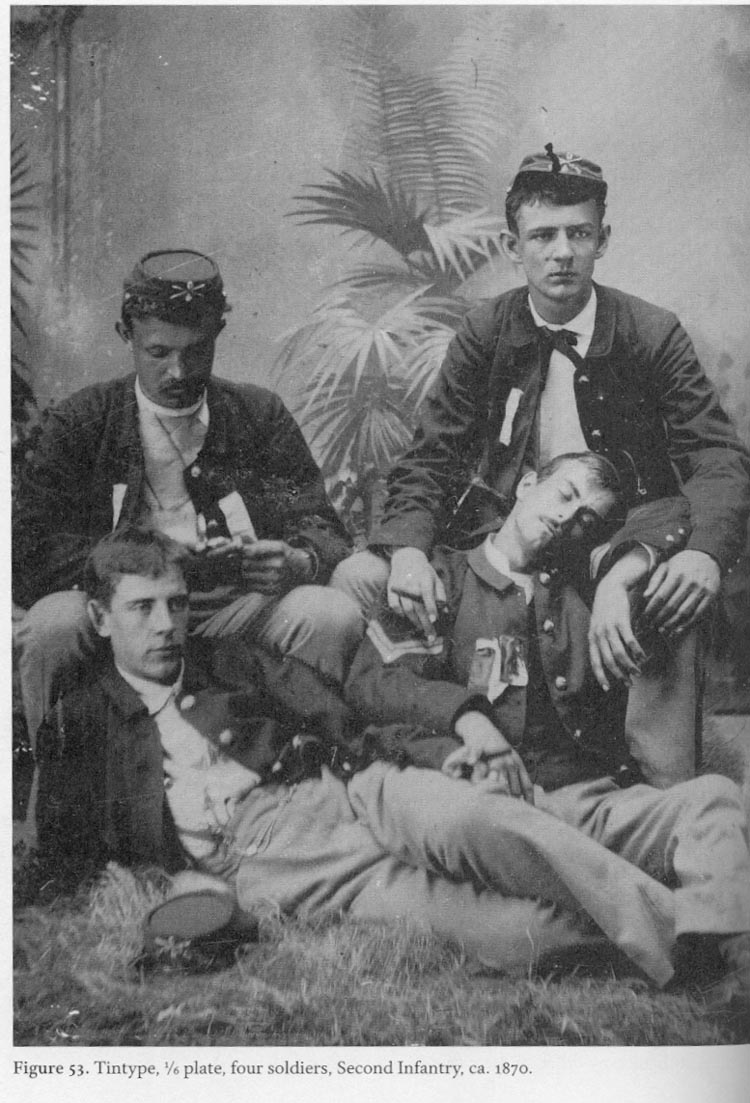
This image is from John Ibson's Picturing Men: A Century of Male Relationships in Everyday American Photography.
We first heard of this book through Redd, who posted about it in October 2006 in the message thread started by Tom and titled Bonds Among Soldiers, World War I.
And I now have a copy of the book, courtesy of Redd, to whom I'm very grateful, as I hope you all will be, because Professor Ibson's is a work of great scholarship.
And I say that having read only a couple chapters -- the book is heavily footnoted and not easy going.
But it's well worth the effort.
I suppose I should hedge my bets by saying that, having only read part of the book, it's unlikely that John Ibson and Bill Weintraub are going to agree on everything, particularly not in an area as fractious as the sexual culture wars.
But this is a good book, and Ibson has done the community of Men who Love Men a great and genuine service by collecting these photographs -- which run roughly from 1850 to 1950 -- and then so carefully researching them and their era and so thoughtfully thinking through what they mean.
Now, as Redd noted back in 2006, although Ibson, who's chair of the Department of American Studies at Cal State, Fullerton, doesn't use the term heterosexualization, the process he describes is exactly that:
a change from a way of life which was characterized by single-gender / homosocial spaces and environments, to one in which mixed gender -- heterosexualized -- environments are common and the culturally-enforced norm.
This change was accompanied by the medicalization of "homosexuality," a term which was coined in 1869.
Speaking of this change, and the nineteenth century, Ibson quotes the French philosopher Michel Focault:
...as long as friendship [between men] was something important, was socially accepted, nobody realized men had sex together. The disappearance of friendship [and the elevation of marriage] as a social relation and the declaration of homosexuality as a social/political/medical problem are the same process.
Foucault was speaking in 1982, and I don't know that I agree with every word he said, since for one thing our understanding has changed and evolved since then.
For example, Foucault says, "nobody realized men had sex together."
That's not true.
As Ibson makes clear, the MEN KNEW they had sex together.
They were as aware of that as Men have ever been.
But what Foucault is saying is that the "disappearance" -- I would call it the DESTRUCTION -- of male friendship as a social relation plus the elevation of marriage "and the declaration of homosexuality as a social/political/medical problem are the same process."
And that's correct.
In other words, the DESTRUCTION of male friendship is part of "the same process" by which homosexuality is declared "a social/political/medical problem."
And at the same time, the destruction of male friendship "as a social relation" is accompanied by an elevation of heterosexual marriage.
And that's the vital insight -- no matter how you word it.
Once again, the point is that the destruction of MEN via the destruction of MALE INTIMACY -- and the creation of "homosexuality" -- are the same deal.
So, put differently, and as we've often said, prior to 1869, there were no "homosexuals," there were simply people and sex acts.
That changed, says Ibson,
in the late nineteenth century, as the words "heterosexual" and "homosexual" gradually entered the language[, and] opprobrium shifted from an activity itself to persons thought to be oriented toward such behavior.[emphases mine throughout]
He then quotes historians John D'Emilio and Estelle Freedman, who say,
Same-sex relationships thus lost the innocence they had enjoyed during most of the nineteenth century [once] medical labeling of same-sex intimacy as perverse conflated an entire range of relationships and stigmatized all of them as a single, sexually deviant personal identity.
So -- as my foreign friend has said, the creation of the false categories of "sexual orientation" doomed male-male intimacy, mutilating and negativising it and shunting its sexual expression into the "gay" ghetto.
To make his case, Professor Ibson has collected, through flea markets and swap meets and eBay auctions, a large number of nineteenth and early twentieth century studio photographs of American men.

What one sees in these pictures -- men holding hands, men sitting in each other's laps, men with their arms about each other, men physically and emotionally intertwined in a number of other very striking ways -- is very powerful, and made more so by Ibson's amply documented observation that
professional portraits of men together in the late nineteenth century were often taken by someone well known to the sitters, in a studio in the center of their town, with their neighbors in the waiting room. That so many American men were comfortable enough in this environment to pose the way they did is highly revealing.
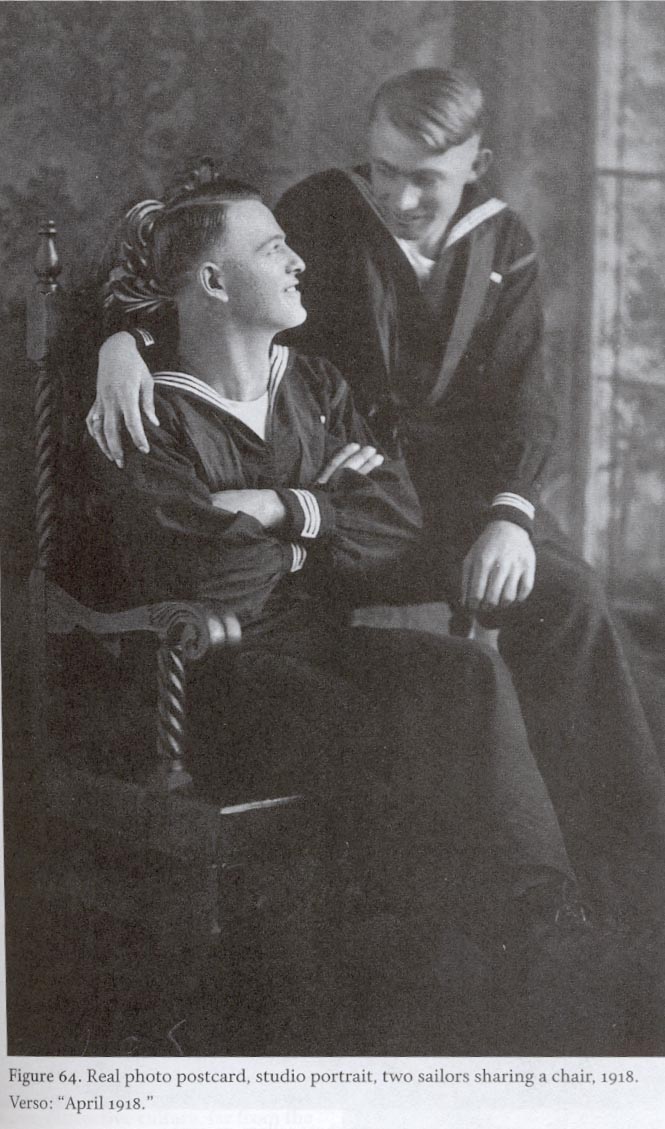
"Highly revealing," says Professor Ibson.
No kidding.
The caption says that this was a "photo postcard," which means it was meant to be sent through the mail.
That's revealing.
And that's not all that's revealing.
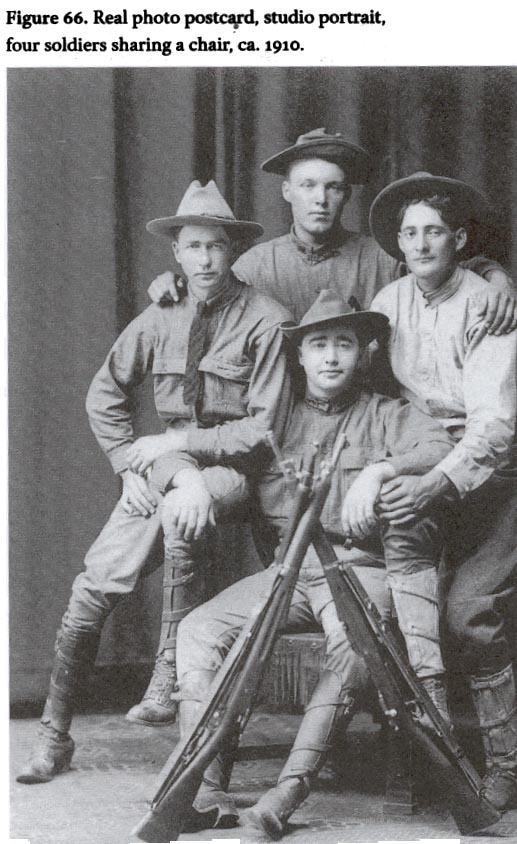
Because Ibson produces a startling statistic:
That in the late nineteenth century, more than 40 percent of all men over the age of fifteen -- were not married.
A bachelor subculture, with enclaves of singleness flourishing in street-corner gangs, boardingschools, the YMCA, rooming houses, colleges, the workplace, lodges, saloons, pool halls, and sporting events, was another manifestation of gender segregation, of particular importance in the late nineteenth century when bachelors were so numerous -- more than 40 percent of all men over the age of fifteen in the United States. Recent research has shown that the large number of single men was not linked to a shortage of marriageable women or to economic uncertainties as much as to the fact that many men simply preferred bachelorhood.
40 percent -- what a statistic!
And in a footnote, Professor Ibson tells us how the figures shifted as what we call heterosexualization proceeded apace:
Of American men fifteen and older, 42 percent were bachelors in 1890, 33 percent in 1940, and only 25 percent in 1950.
That is heterosexualization, and it's not a figment of anyone's imagination -- it's right there in the stats.
MEN didn't change -- the culture changed.
I know this from my own family.
My father, who was born in 1901, was the only child in his family of three sons and one daughter to marry, and he married comparatively late in life -- when he was forty.
That is to say, in 1941.
Which means that when he was born, easily 40% of men were bachelors.
By 1940, only 33% were -- and he joined the trend, and got married too.
But not all the men in his cohort did.
His brothers never married, and he had friends -- contemporaries -- who never married either.
None of these men were, in my boyhood, considered "gay."
They were simply referred to as "confirmed bachelors" -- and nothing else was said.
Now what about INTIMACY?
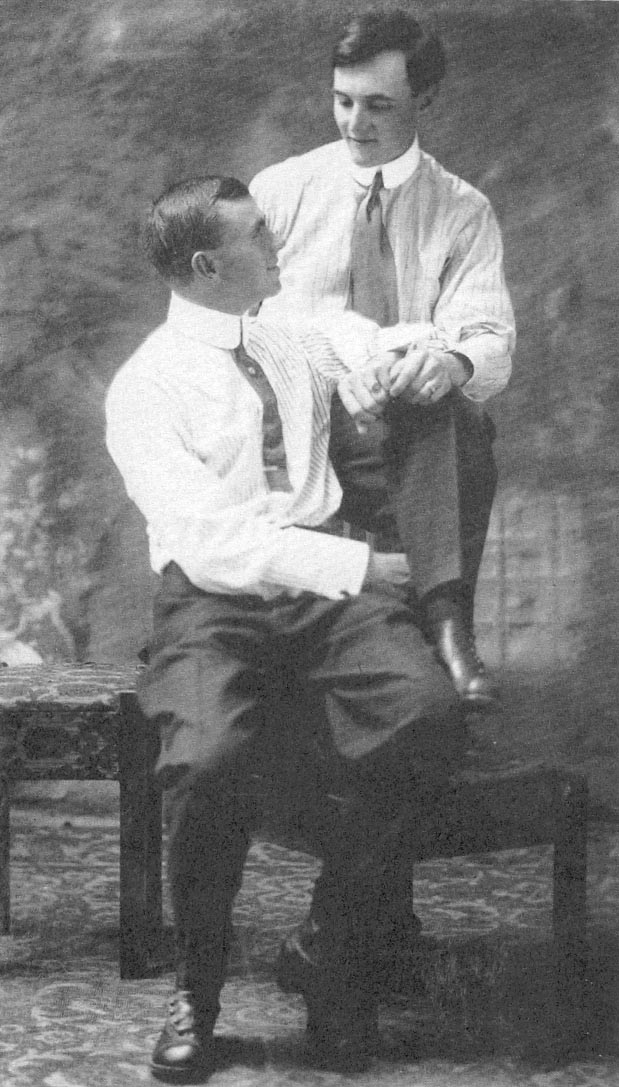
[Caption:] Figure 29. Real photo postcard, studio portrait, two men holding hands ca 1910. Verso: "I don't know if I sent you one like this or not but it wont hurt to send you another if I did. myself and Kent."
Dr. Ibson has looked at the photographic evidence:
When it comes to nineteenth century photographs, clearly more emotional bliss was displayed in those of men together than in those of men and women. Though surely some of that bliss was erotically inspired, what is most notable and unequivocal in the portraits of two or more men is simply the comfort of male association.
"the comfort of male association" -- the ease of male intimacy.
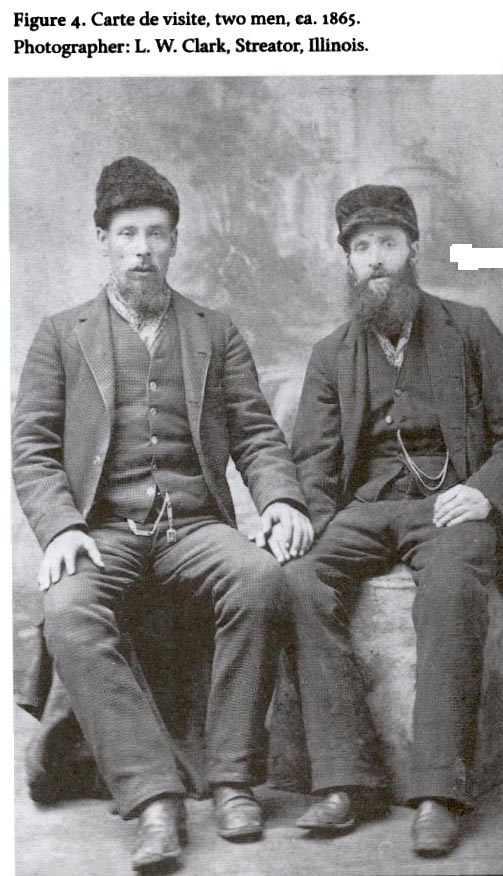
And that's one of the things which is so striking about the photographs Ibson has collected.
In male same-sex photographs today, what you most often see is lasciviousness and lust.
Which of course is a reflection of analist culture.
What you see by contrast in the vintage photos is playfulness, good fellowship, tenderness and male intimacy.
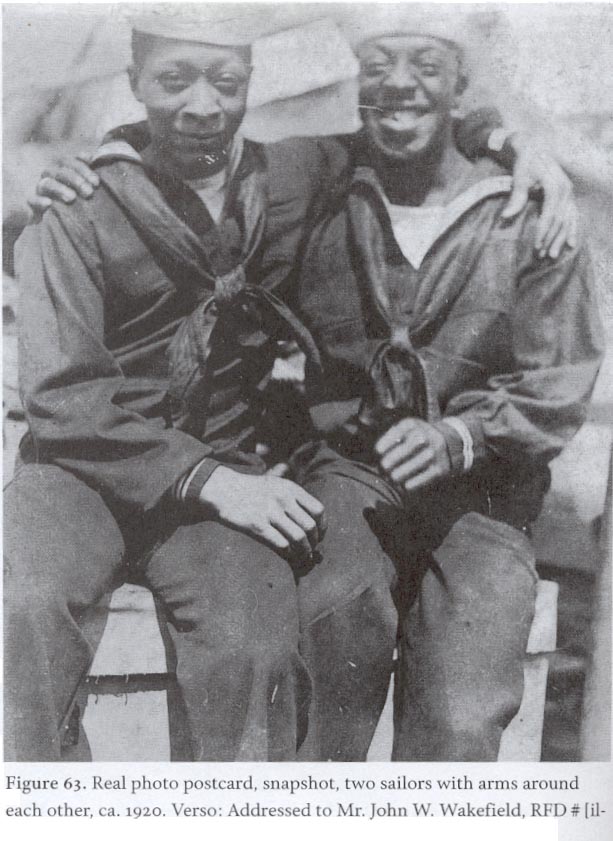
Quite a contrast.
And speaking of male intimacy, having told us about the "street-corner gangs, boardingschools, the YMCA, rooming houses, colleges, the workplace, lodges, saloons, pool halls, and sporting events" -- all of which were predominantly all-male or homosocial spaces -- Professor Ibson then discusses the American West:
The largely all-male communities of miners and cowboys in the nineteenth-century West were also influenced by and were fertile ground for the cultural endorsement of men's love for each other. In his popular 1922 novel Ted, Clarence Mulford (author of the Hopalong Cassidy series) wrote of dancing miners: "A roar of laughter came from the celebrating miners and all turned their way. Sinful and Hank were dancing to the music of the jew's harp and the time set by stomping hob-nailed boots. They parted, bowed, joined again, parted, curtsied, and went on, hand in hand, turning and ducking, backing and filing, the dust flying and the perspiration streaming down."And cowboy Badger Clark's somewhat earlier poem, "The Lost Pardner," was hardly inhibited in dealing with a friend's death:
We loved each other in the way men do
And never spoke about it, Al and me.
But we both knowed, and knowin' it so true
Was more than any woman's kiss could be ...The range is empty and the trails are blind,
And I don't seem but half myself today.
I wait to hear him ridin' up behind
And feel his knee rub mine the same old way.He's dead -- and what that means no man kin tell.
Some call it "gone before."
Where? I don't know, but God! I know so well
That he ain't here no more!
That's a lament for a lost male intimacy which is as old as Gilgamesh, as old as the Iliad, as old as the Thebaid -- and a lot older.
It's as old as Mankind.
John Ibson:
What John Donald Gustav-Wrathall has written about the YMCA may apply to many areas of American life in the late nineteenth and early twentieth centuries. Arguing that "the primary force behind the creation of the Young Men's Christian Association in North America was that young men simply liked being together," Gustav-Wrathall has said that "in focusing on the intense nature of the bonding, I am not suggesting that the YMCA was a homosexual organization. I am suggesting that homoeroticism and intense homosocial bonds are a more important part of male culture than has previously been imagined."[emphases mine]
To which I once again say, No kidding.
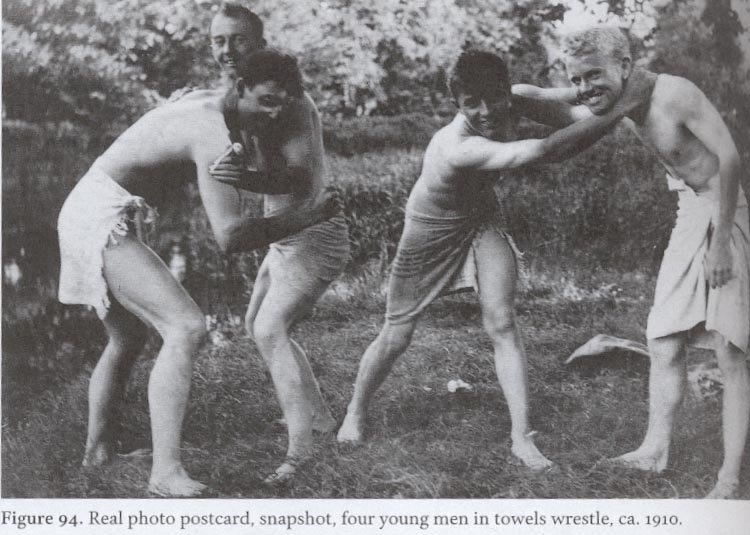
Mr Gustav-Wrathall says that "young men simply [like] being together";
and adds, "homoeroticism and intense homosocial bonds are a more important part of male culture than has previously been imagined."
But that begs the question: imagined by whom?
By twentieth-century academics, cowed by homophobia and MAN-phobia?
Sure.
But that young men like being together and that "homoeroticism and intense homosocial bonds" are important not just to male culture and MEN but to all of society -- would hardly have been a surprise to the Sumerians or the Greeks or the Romans or the Celts or the Samurai etc etc -- the list is basically infinite.
The people who are startled by that idea are the sickly male denizens of our heterosexualized present -- not the true and NATURALLY MASCULINE MEN of our WARRIOR past.
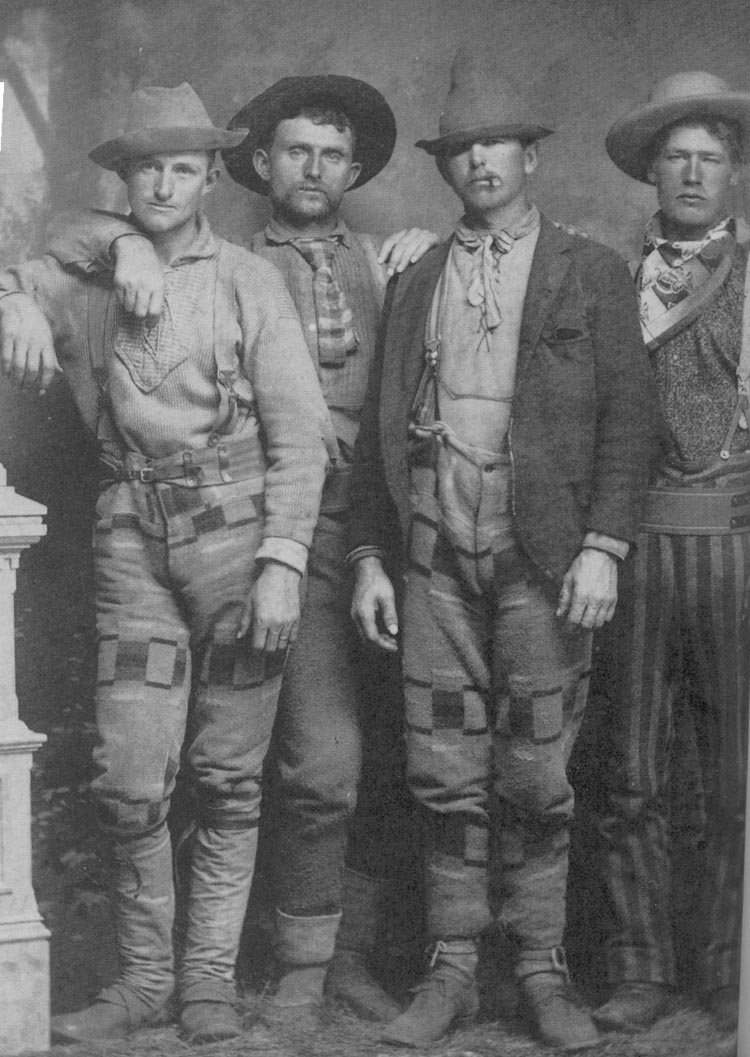
So:
The sort of intimacy between Men you see in the photographs from World War II was not and is not unique to World War II.
But -- there's no question that war, as I think Ibson agrees -- he titles his chapter about World War II "Men Set Free" -- promotes a very deep and profound intimacy between Men.
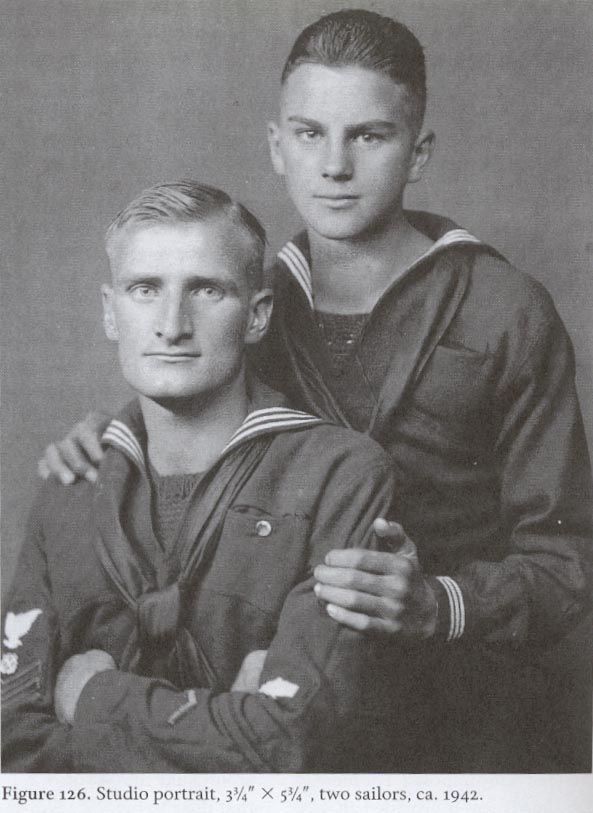
INTIMACY is a part -- and indeed a crucial part -- of the dynamic created by Men at War:
Warriors.
Why am I stressing this?
Because Warriors are what most Men have been most of the time throughout most of the existence of the human race.
Which means that male intimacy is not incidental to Men.
It's crucial.
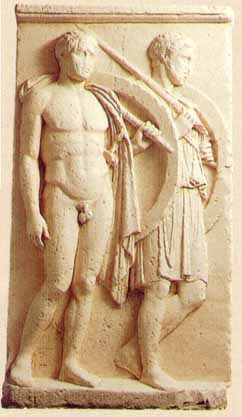
But men today don't understand that.
Redd:
They don't understand brotherhood or warriorhood. They don't appreciate the masculine. They really don't know the masculine.
Once again, that ignorance about what masculine is, what brotherhood is, is one of the reasons our work is so important.
Right.
Men "really don't know the masculine."
And you have to ask: How can Men live -- if they don't know the masculine, are ignorant about what masculine is, what brotherhood is?
The answer is -- they can't.
Their existence is a subsistence.
They don't thrive.
Which is why, as Redd says, our work matters.
Thank you Redd.
You're a true Warrior.
And again I thank Redd and I hope you all will for introducing John Ibson's work to the Alliance.
Guys, if you're interested in purchasing Ibson's book, you can find it on amazon.
Or, here are the ISBN numbers:
ISBN-10: 0226368580
ISBN-13: 978-0226368580
Or you can just request a copy at your local library.
There are more than 140 photographs in the book -- you owe it to yourself to see those pix and really begin to understand how much has been lost --
and how much could be gained.
Bill Weintraub
August 27, 2007
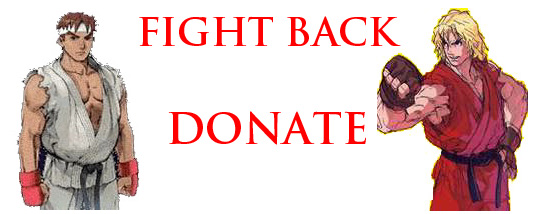
© All material Copyright 2007 by Bill Weintraub. All rights reserved.
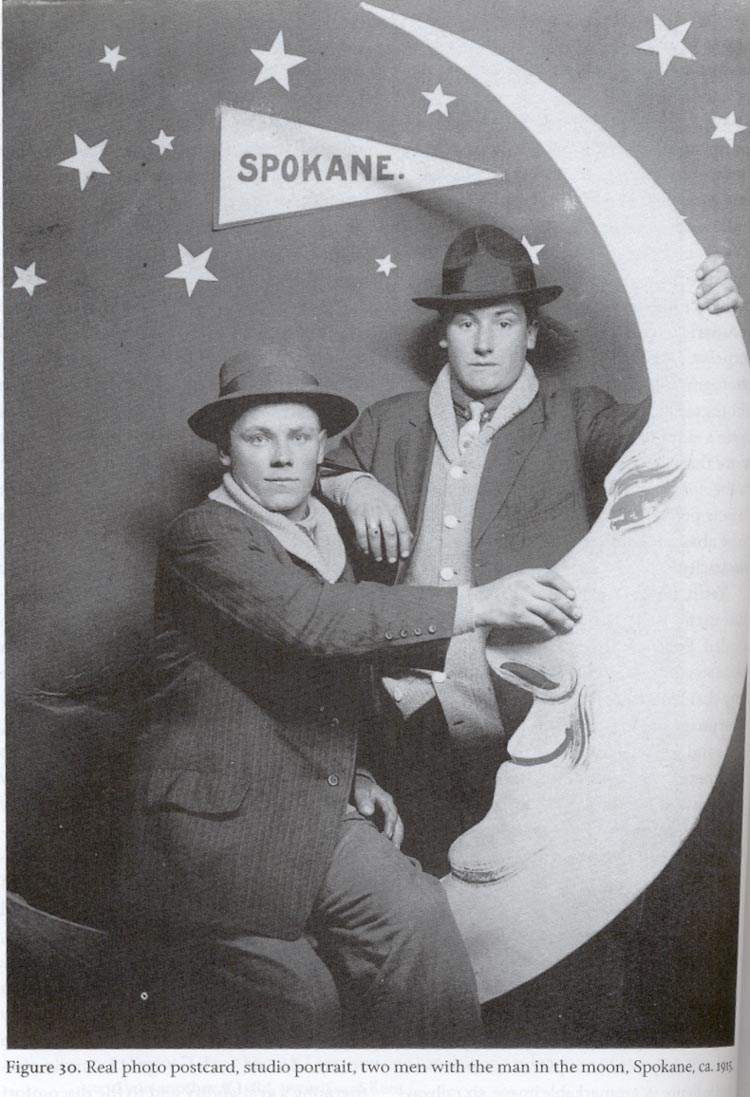
Re: Warriorhood and Male Intimacy
9-7-2007
This is such a great post, Thank you for repeating it. Every man should read this and take heed.
Bill G
Related post: She Didn't Understand
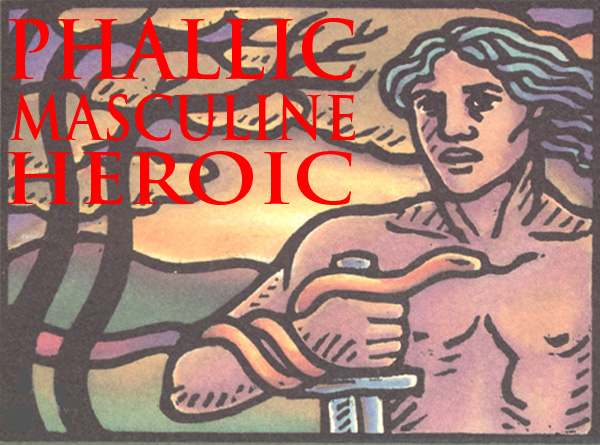



AND


Warriors Speak is presented by The Man2Man Alliance, an organization of men into Frot
To learn more about Frot, ck out What's Hot About Frot
Or visit our FAQs page.

| Heroes Site Guide | Toward a New Concept of M2M | What Sex Is |In Search of an Heroic Friend | Masculinity and Spirit |
| Jocks and Cocks | Gilgamesh | The Greeks | Hoplites! | The Warrior Bond | Nude Combat | Phallic, Masculine, Heroic | Reading |
| Heroic Homosex Home | Cockrub Warriors Home | Heroes Home | Story of Bill and Brett Home | Frot Club Home |
| Definitions | FAQs | Join Us | Contact Us | Tell Your Story |

© All material on this site Copyright 2001 - 2010 by Bill Weintraub. All rights reserved.
